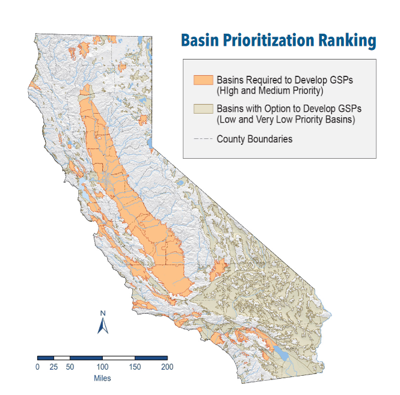Groundwater is a vital water supply for Californians who have been affected by prolonged drought and unreliable surface water supplies.
Over the last decade, we have seen reservoirs across the state drop to historic lows. Fortunately, in recent years we have seen them recover. When surface supplies dwindle and rain does not come to the rescue, California water agencies become more dependent on groundwater supplies to meet their customers’ water demands.
Additionally, during droughts, the agricultural sector becomes more dependent on their private wells to ensure that their crops survive the dry and oftentimes unpredictable conditions to produce food. According to the Department of Water Resources, groundwater accounts for 60% of California’s total water supply during drought and 40% in average years.
Throughout California, unregulated groundwater use has resulted in damaged infrastructure including buckled roads, cracked foundations and land subsidence (settling or sinking of the Earth’s surface). Groundwater dependence and overdraft have also caused water quality issues such as seawater intrusion (the movement of ocean water into freshwater aquifers).
These negative impacts have highlighted the need to properly manage these shared groundwater resources. The Sustainable Groundwater Management Act (SGMA) was passed in 2014 to ensure that groundwater resources are protected and brought into sustainable management within 20 years. Each groundwater basin in the state was ranked as either a high, medium, low or very low priority basin, shown in the attached graphic.
Those ranked as high- or medium-priority were required to create Groundwater Sustainability Agencies (GSAs) and submit Groundwater Sustainability Plans (GSPs). The Carpinteria Groundwater Basin (CGB) was designated as a high-priority basin in 2018 by the Department of Water Resources (DWR) and was required to form a GSA and develop a GSP.
The Carpinteria Groundwater Sustainability Agency (CGSA) was established in 2020; administrative and operations costs were funded through a loan from Carpinteria Valley Water District (CVWD) for fiscal years 2021 and 2022.
In fiscal year 2023, the CGSA moved to collecting revenue from properties overlying the groundwater basin boundary that benefitted from groundwater. The fees were calculated based on the acreage overlying the basin; fees came out to $48.00 an acre for fiscal year 2023 and $68.00 an acre for fiscal year 2024.
In fiscal year 2025, the CGSA is implementing fees based on the estimated groundwater extracted by each parcel during fiscal year 2022. This switch from acreage-based fees to estimated pumping fees was made after receiving feedback from the community through public meetings and based on recommendations from the Carpinteria Groundwater Sustainability Planning Advisory Committee (GSPAC).
The fees for fiscal year 2025 will be assessed per acre-foot of groundwater estimated during the period between July 1, 2021 and June 30, 2022. These calculations were based on the crops identified on each property according to aerial imagery from 2022 and the calculated crop application rates for this period.
Letters and maps were mailed out to impacted property owners in Fall 2023, outlining the crops identified and the estimated groundwater extraction calculated for the property. Owners were allowed to provide supplemental information to demonstrate whether groundwater extraction estimates or crops were incorrect. This has been a data-gathering exercise for the CGSA in the absence of metered private wells.
The per acre-foot charge has not been determined at this time; the CGSA is wrapping up its correspondence with private well owners who reached out requesting amendments. To stay informed of meeting agendas and other CGSA updates, we recommend that you sign up at: carpgsa.org/public-info/sign-up-to-receive-email-updates.
As for recent CGSA news, the GSP for the Carpinteria Groundwater Basin was officially adopted at the Jan. 24 CGSA Board meeting and was submitted to DWR for their review. DWR has two years to respond and comment on the GSP.
In the meantime, the CGSA will begin our required annual reporting to DWR this year to provide an update with the most recent water quality and water level observations within the basin. We thank the local property owners who have been participating in the groundwater monitoring program, which has been collecting data for over two decades.
One of the first major projects for the CGSA is wrapping up at El Carro Park. Three monitoring wells were drilled along the western edge of the park. Staff will now be able to take quarterly groundwater samples in the central portion of the groundwater basin at these distinct monitoring wells and will have geophysical induction logs performed. These logs record the electrical conductivity of the aquifers and help monitor for any changes in the salt content of the water.
With the new El Carro Park monitoring wells and existing Sentry Well monitoring wells along the coast, the CGSA will have a better picture of local aquifer conditions over time.
For more information about the CGSA, please visit carpgsa.org and sign up for e-mail updates using the URL provided above. If you have any questions related to SGMA or the CGSA, please contact sgma@cvwd.net.
Robert McDonald is the executive director of the Carpinteria Groundwater Sustainability Agency. He can be reached at bob@cvwd.net or sgma@cvwd.net.



















(0) comments
Welcome to the discussion.
Log In
Keep it Clean. Please avoid obscene, vulgar, lewd, racist or sexually-oriented language.
PLEASE TURN OFF YOUR CAPS LOCK.
Don't Threaten. Threats of harming another person will not be tolerated.
Be Truthful. Don't knowingly lie about anyone or anything.
Be Nice. No racism, sexism or any sort of -ism that is degrading to another person.
Be Proactive. Use the 'Report' link on each comment to let us know of abusive posts.
Share with Us. We'd love to hear eyewitness accounts, the history behind an article.